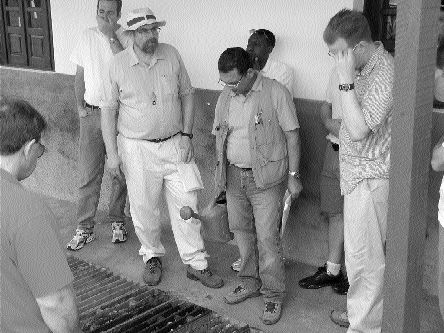Pindobau, Brazil — The principal test of a new model for gold mineralization in the Jacobina gold camp of Bahia state, Brazil, is a program near the northern end of the Serra de Jacobina, the line of hills that gives the area its shape. There, drilling by
The Serra de Jacobina is built of conglomerate and finer sedimentary rocks of the 2-billion-year-old Jacobina Group, surrounded by gneisses and greenstones that are mainly 400 million to 1.4 billion years older. The conglomerates are cut by shallow-dipping thrust faults, and the gold mineralization in the main Jacobina area, where most of the production has come from, mostly occupies “reef” structures parallel to the bedding in the Jacobina sediments.
From that, it had been easy to conclude that the gold’s geological similarity to the deposits of South Africa’s Witswatersrand basin meant genetic similarity as well. But that worked only if local, but sometimes significant vein mineralization, “shooty” grades that rose near fault systems, and widespread hydrothermal alteration minerals like the chromian mica fuchsite, were left out of the picture. And ultramafic sills and dykes are common along the length of the Serra, occasionally playing host to gold mineralization.
So a more complete picture of what makes an ore deposit on the Serra de Jacobina needs more of a model than simple Wits-style placer deposition. The model that is emerging in the minds of Desert Sun’s exploration staff is of a series of fluid pulses along the more permeable planes in the sequence — including all three of porous sedimentary beds, coarse-grained sedimentary channels, and later structural breaks. Earlier pulses mainly introduced silicate minerals like quartz and fuchsite, while later ones emplaced gold and sulphide minerals.
The fluids were sweated out of the existing sediments during high-grade metamorphism, which characteristically converts hydrous minerals to anhydrous ones. Following the peak of the metamorphic event, when the ultramafic sills and dykes intruded the sedimentary sequence, the excess fluids leached gold, along with the associated metals, from the ultramafics. Fluids, which have an obliging habit of going wherever the going is easiest, moved along the available plumbing in the Jacobina sediments, leaving metals behind as they cooled.
Presuming that model gets close to reality — and it explains more of the area’s features than other models have — then it should cause more targets to pop up. The big geological questions remaining for exploration in the belt centre on what kind of plumbing — the sedimentary channels, the structures, or the beds — did more to move the fluids around. The big mining question is, as always, whether there is enough mineralization to put together a resource.
Right at Pindobau, drilling has returned gold grades well above the mining grade at Jacobina, including 5.5 grams per tonne over 21.9 metres, 7.2 grams per tonne over 2 metres, and 6.6 grams per tonne over 1.9 metres. Other holes hit wider zones of lower grades — a fraction of a gram over 6-18 metres, for example.
At the time of The Northern Miner’s visit, Desert Sun planned to do induced-polarization surveys to pick out areas of disseminated pyrite, which invariably accompany gold mineralization. The company is mapping the geology of the belt at a 1:5,000 scale, and prospect areas at 1:1,000.
About US$1.5 million of the company’s US$5-million exploration budget is going toward work on the northern end of the Jacobina belt.
The evidence certainly falls on the side of the northern prospects being part of a large hydrothermal system. About 5 km north of Pindobau, Desert Sun has drilled the “Entry Point” target, which represents, geologically, the river-mouth where sediment spilled into an opening basin. It is reasonable to imagine that the faster water flow near the river mouth would scour more and bigger sedimentary channels, so Desert Sun has seen the target as having prime potential for mineralization. (And if the opinion needed reinforcing, there were garimpeiro workings on top.)
Four drill holes in the area intersected the right rocks, with local disseminations of pyrite and with some fuchsite alteration, but gold values were only in the 0.1-gram to 0.6-gram-per-tonne range. The result doesn’t need to be explained away so much as understood: even in the best channels, fluids move, and the conditions for deposition aren’t present all along them.
A further 6 km north of Entry Point, at Fumaca, Desert Sun drilled another four holes. One hole, down-dip from a 10-metre intersection grading 0.7 gram gold per tonne, cut 3.6 metres grading 1.37 grams per tonne. Another hole returned 0.86 gram over 1 metre.
The results show the usefulness of both geology and geophysics in exploring a target with as subtle an appearance in drill core as these; a handle on pyrite concentrations, from induced-polarization surveys, or an idea of where the permeable beds and channels are, from sedimentological mapping, narrows the field a great deal.
Fumaca, Entry Point and Pindobau all fall on the eastern edge of a “window” of Jacobina Group conglomerates, where overthrust Archean-aged greenstones have been eroded away. That contact is a zone of very strong silicification, with gold occurrences known all along it. Not coincidentally, the thrust contacts are where most small-scale mining has been done.
When the Miner visited, local garimpeiros were working near the Pindobau prospect, recovering free gold by crushing and mercury amalgamation. While the small-scale mining has no legal status, the Brazilian government has little choice but to tolerate it, rather than outlaw it and force garimpeiros out of work. From the point of view of the exploration companies, the garimpeiros are a volunteer prospecting crew, and the long-term hope of both government and industry is to use modern mining to clean up the environmental damage that comes from unregulated small-scale mining.


Be the first to comment on "Pindobau a test case for new model at Jacobina"